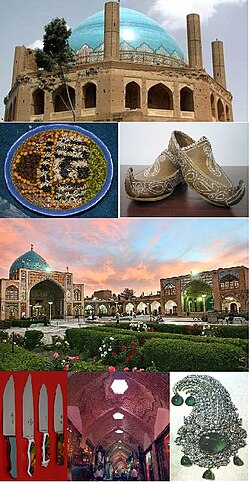Zanjan, Iran
|
Zanjan زنجان زنگان |
||
|---|---|---|
 |
||
|
||
| Coordinates: 36°40′N 48°29′E / 36.667°N 48.483°ECoordinates: 36°40′N 48°29′E / 36.667°N 48.483°E | ||
| Country |
|
|
| Region | 3 | |
| Province | Zanjan | |
| County | Zanjan | |
| Bakhsh | Central | |
| Government | ||
| • Mayor | Habibullah Yeganeh | |
| • Parliament | Waqfchi & Ahmadi | |
| Elevation | 1,638 m (5,374 ft) | |
| Population (2016) | ||
| • Total | 433,475 | |
| • Rank | ||
| City & County | ||
| Time zone | IRST (UTC+3:30) | |
| • Summer (DST) | IRST (UTC+4:30) | |
| Website | www.Zanjan.ir | |
Zanjan (![]() pronunciation Persian: زنجان, Azerbaijani: زنگان) is the capital of Zanjan Province in Iranian Azerbaijan. It lies 298 km (185 mi) north-west of Tehran on the main highway to Tabriz and Turkey and approximately 125 km (78 mi) from the Caspian Sea. The city is located about 20 kilometers south of the Qaflankuh Mountain Range. At the 2016 census, its population was 433,475 which is the 20th largest city in Iran. The population of Zanjan consists mostly of Iranian Azerbaijanis who speak Azeri Turkish.
pronunciation Persian: زنجان, Azerbaijani: زنگان) is the capital of Zanjan Province in Iranian Azerbaijan. It lies 298 km (185 mi) north-west of Tehran on the main highway to Tabriz and Turkey and approximately 125 km (78 mi) from the Caspian Sea. The city is located about 20 kilometers south of the Qaflankuh Mountain Range. At the 2016 census, its population was 433,475 which is the 20th largest city in Iran. The population of Zanjan consists mostly of Iranian Azerbaijanis who speak Azeri Turkish.
Zanjan is known for its beautiful handcrafts such as knives, traditional sandals, called charoogh, and malileh, a handcraft made with silver wires. Zanjani artists make many things like various decorative dishes and their special covers as well as silver jewelry. In ancient times, Zanjan was known for its stainless and sharp knives. But this tradition is gradually becoming extinct by introduction of Chinese-made knives into the market which are far cheaper, more abundant and of course less artistic. Many villagers today are traditional carpet weavers, perhaps Zanjan's most popular handcraft. Zanjan's population boasts the highest level of happiness among the people of 30 other provinces in Iran, according to a detailed survey conducted by Isna.
Hamdollah Mostowfi, the Iranian traveler and historian, in his book claims that Zanjan was built by Ardashir I, the first king of the Sassanid Empire and named as "Shahin". One important moment in the history of the city was in 1851 when the city became a center for the Babi uprisings, along with Neyriz and a fortress known as Shaykh Tabarsi. The forces of the central government captured the Babi fort in Zanjan after a long siege on the orders of Grand Vizier (Prime Minister of Iran) Amir Kabir and killed or expelled the Bab's followers. According to Bosworth, who quotes Hamdollah Mostowfi, the inhabitants during the Ilkhanid era spoke "pure Pahlawi", a Median or northern form of Persian.
...
Wikipedia


